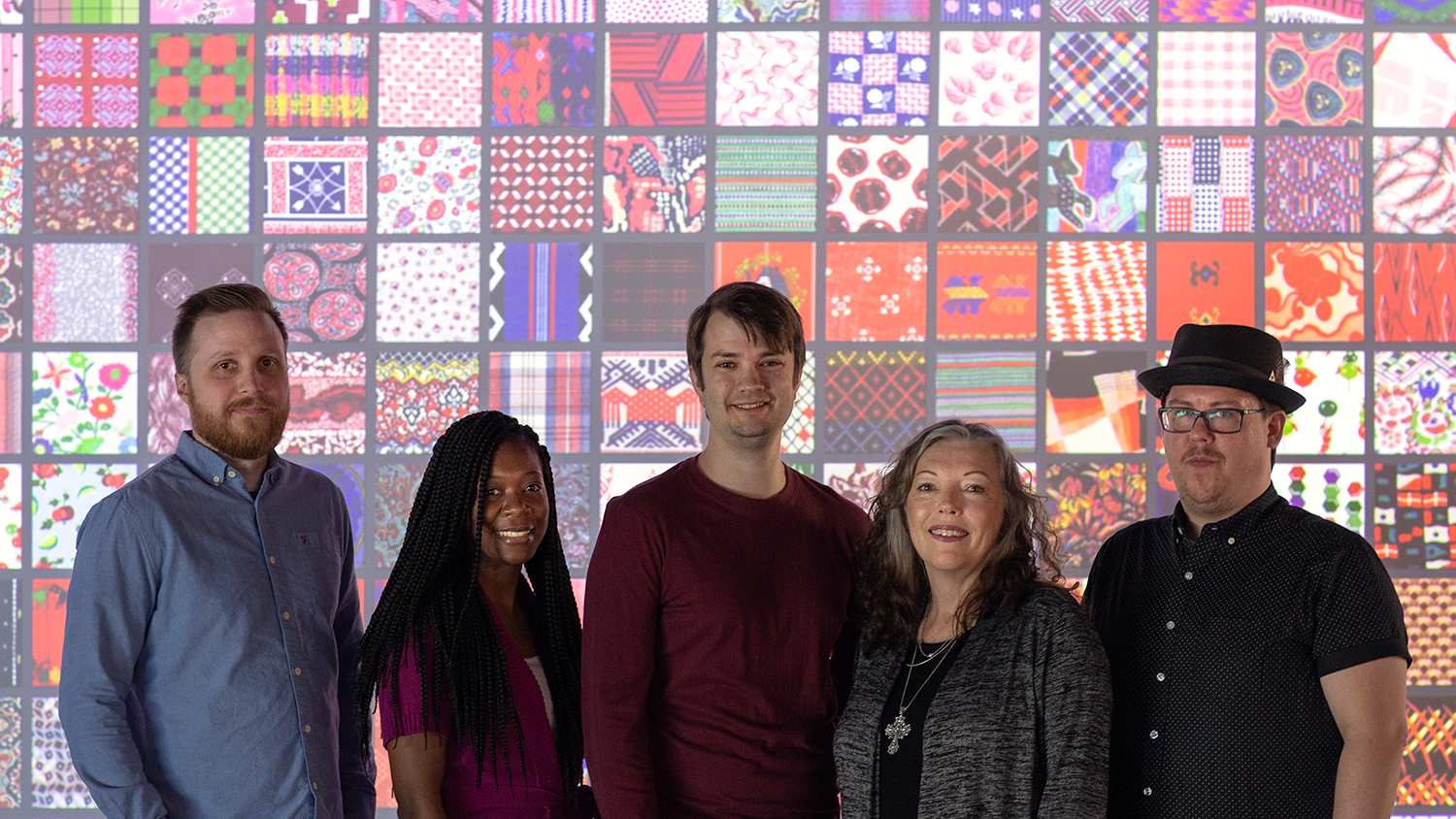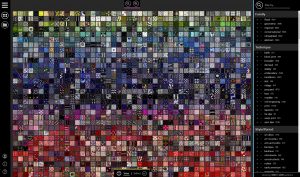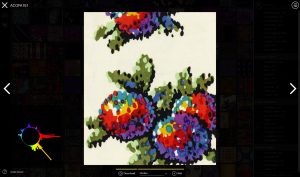Textile Archive Design Application: Bridging History and the Future of Textile Design

A team of DELTA staff helped Textile and Apparel, Technology and Management Professor Traci Lamar bring back the ’90s in a big way.
During the 2017-2018 DELTA Grants cycle, the team remodeled MONA: The Textile Design Explorer, a database built to inspire design professionals as they craft their own textiles and designs. Lamar recalled using the application to teach design students in the late 1990s, and wanted to reincorporate it into her Fashion and Textile Design and Textile Technology classes at Wilson College of Textiles.
“It was landmark at the time,” she explains. “Nobody else was doing digital archiving and making that accessible. In some ways, it was before its time.”
The only problem? MONA was ancient. Project Lead and New Media Developer David Tredwell puts its age in perspective. “In the technology sense, this is an old application. [It only worked] on one computer, so an entire class would have to book time to sit down and use it.”
To add an extra layer of difficulty, MONA was incompatible with modern computers, and the project team couldn’t see or use it. They were tasked with what seemed impossible – to revive a technology that was buried beneath years of inactivity and almost entirely inaccessible.
But MONA’s potential for student success outweighed its limitations. To provide students with historical context, expose them to new concepts and, ultimately, make them better designers, the team said, “Let’s bring this tool back for students to use.”
With a new purpose in the digital era, MONA was rebranded to TADA: Textile Archive Design Application.
Starting with a Student-Centered Approach
Revamping TADA revolved around student success. “They can use this as one of the tools in their tool belt to enrich the designs that they’re creating,” explains Tredwell. To achieve this effect, the team had several goals in mind.

“We really wanted to encourage exploration [in the sense of exposure]. In the brainstorming phase, they’re working with a richer pool of examples. It exposes them to terminology with which they might not be familiar.”
Instructional Designer Jessica White expands on Tredwell’s idea. “Research isn’t just about looking through databases and journals,” she says. Visual exploration tools like TADA offer a new and unconventional approach to a term project or research paper.
In the field of design, a broad mindset is important, and TADA works to establish this. It’s not like mathematics or chemistry; there’s no right or wrong answer. In fact, ideas that combine concepts and escape boundaries are encouraged. Lamar calls these “gray-area solutions.”
“Sometimes the students don’t pick up on the diversity and range of techniques in a particular area of textile design.” Lamar appreciates how TADA allows them to see the ways that textile design has existed and evolved over time. “It helps them see more broadly the kinds of things that they might be able to do in taking advantage of modern technology, but also leveraging the aesthetics of a previous time period or another style, perhaps even halfway around the world.”
From MONA to TADA
Although MONA had yet to turn 30, it was extremely outdated and virtually irretrievable for modern use by the time the project team was first introduced. “It felt like it was from an older civilization,” says Tredwell. To get to know MONA as it was in its prime, the team had to do some digging.
Originally conceived as a sophisticated design inspiration tool for industry professionals, MONA had a lot to offer. With nearly 3,500 patterns in its database, the application provided a visual collection of textiles dating back hundreds of years, organized by broad categories and specific filters. Despite its impressive digital composition, its physical structure and functionality left much to be desired.
Having spent years inside a storage room, the application lay dormant on 40 CDs. Once it was unearthed, an even bigger challenge was discovered. It had fallen out of maintenance over the years, missing key updates and improvements that would allow it to run on modern computers. It simply didn’t work anymore.
As MONA became inaccessible, so did its value to students. Lamar felt that there must be a way to bring it back, or as Tredwell puts it, “revitalize, resurrect and rethink,” the tool for students to use. Lamar explains, “That’s what inspired me to write the project — there may be a way to bring back a meaningful use for the students, where they could not only look at ideas and inspiration, but also look at them in particular time periods or styles.”
Excavation and Challenges: “App Archaeology”
The team faced mounting challenges as they approached TADA; perhaps most daunting was the inability to actually see the application aside from about two dozen screenshots. “We couldn’t see it. We couldn’t use it in action,” laments Tredwell. “We had to have long discussions about how we thought it should work.”
Entering in the dark meant making adjustments to the team’s specialized roles. For Tredwell, developing the app required innovating new strategies. “We used an iterative approach. We did a bunch of prototypes, but they were really early. We could say ‘Here’s what we like about it, here’s the feeling we’re getting out of this — let’s make some decisions and refine it as we go.’”

Tredwell was able to decode different categories, filters and date information by combing through the application with a binary file reader. After translating the data to a readable form, he had some information to move forward. From there, the focus turned to advanced color coding, organized to spark exploration. “Each time you load the application, the images are organized a little bit differently. We wanted to expose them more than we wanted them to look at the same 20 images.”
If you open TADA now, you’ll see a rainbow of colors flutter across the screen. “All of the images were organized by whatever CD they came from, but we figured out a way to analyze their color, and it let us organize them visually.”
As White worked with Lamar to design course activities with TADA’s new capabilities, she also had to reverse her thinking. “Backwards design helped. We had to go from what we thought the app was going to look like and design backwards from there.”
To ensure that TADA would be incorporated effectively, the two mapped their objectives for both the application and coursework. As TADA came to life, they matched its features to appropriate projects and assignments.
Lamar’s memory proved to be the most valuable excavation tool of all. The team at DELTA asked her specific questions about MONA in its prime, like “What did it do? How did it work? How would somebody use this?” Questions like these allowed them to establish a framework for TADA to rise from.
Securing Ownership
While the team possessed the application itself, the images inside of it were divided among several different owners. This posed a burdensome challenge for the project team. In order to safely use the images in TADA, free of risks like copyright infringement, NC State and Wilson College of Textiles needed to receive permission from the rightful owners.
Connecting with these owners was an entire project in itself. They varied from large organizations like a fashion design school to a family with ties to Guatemala. They also varied in their responsiveness and willingness to provide permission. A design agency in New York City served as the biggest hurdle. While supportive of TADA, they had sold several of their images in the application, but were unsure of which ones. With the best interest of students in mind and time running out before classes, the agency and the team agreed it was best to leave those images out.
Despite the tedium and time crunch, the team looks back on this process with a sense of accomplishment. In Lamar’s words, “[It] was a really big detective challenge.”
TADA in the Classroom
It took months of careful planning to ensure that when students got their hands on TADA, it was more than just a collection of patterns. Instead, it needed to let them explore, travel through time and foster an appreciation for their industry. “It’s an introduction, but it’s also an ongoing resource,” says Lamar. “We can use it as a reference material for the actual designs. I might pull a motif or an element and apply it to a modern design.”
To make sure that these goals for students were met, Lamar and White designed and adjusted a number of course activities to incorporate TADA.
“We started with the scavenger hunt. The students completed that the first day of class,” says White. This activity allowed students to explore the application on their own, embarking on a maiden voyage across its many features and filters. “I didn’t teach them anything about it first,” adds Lamar. “It was a way to see if they were able to pick it up, if it was as intuitive as we hoped it was.”
Once students could successfully navigate TADA, they used it to refine their skills, like in the color reduction and palette lesson. Lamar chose this activity to teach them how to derive precise colors from textile samples and establish color schemes and relationships within their own designs.

TADA was the perfect tool to assist the students as well as Lamar. “I had them find something in TADA to use as their example,” she explains. “It was useful to me from a teaching perspective. I could look at the original image and make an assessment of how well I thought they accomplished the task. It allowed me to give them feedback in terms of how they had mastered the task, and also if there were consistent places that they had challenges.”
The application’s historical breadth was also highlighted in the classroom. For their first project, students created a printed collection of textiles inspired by a historical style or time period. TADA served as a springboard for their research and a way to sharpen their historical focus.
From color perception, to texture mapping, to design briefs, TADA played a critical role. Its unique capabilities benefited students in a number of ways. “Many of the early assignments using the TADA application were skill building, and then we applied those skills to a bigger project.”
Tracking TADA: Student Testing and Response
Outside of the classroom, TADA was designed and tested to serve students in the best possible ways. During its renovation, the team incorporated student testing and impressions to design features and improve their work. “We tested it with students pretty early, even the prototype stuff,” says Tredwell. “We could sort of watch over their shoulders and see how they were doing.”
External applications like Google Analytics and Top Hat helped the team understand how users interacted with TADA, what they liked most and what areas needed focus.
From an instructional design perspective, White explains, “Google Analytics really helped because we could tell what students were looking for. We could also tell how long they were spending on the app or a particular image.” Tredwell also found it useful while designing the app to gain insights about the user experience. He was able to ask, “How did [students] get there? How can we do it better? What kind of behaviors can we see? We know more about how people use it and how students approach activities and assignments. That helps us design better tools.”
Top Hat made it possible for Lamar and White to engage with students and synchronize instruction. They could monitor their progress, interact with results in real-time and steer them in the right direction if they got off track.
Some of the most important insights about TADA came directly from the students themselves. “Not only were they exploring it, they were offering suggestions, like ‘this would be really neat’ or ‘it would be really helpful if I could do that,’” says Lamar. “The fact that they were thinking and using it enough to recognize this was really evidence that they were engaging with it.”
Not long after students were introduced to the app, they began to seek it out for themselves. “Many of them were looking at that database whether I said it was required for the project or not,” Lamar continues. After TADA was launched in fall 2018, it swiftly became in demand for the spring semester. “The students who used it last semester wanted to use it again this semester. To me, that was also really good evidence that they found value in it because they wanted to keep using it.”
Lamar made sure that the app is accessible and versatile for these students. They can load the application, build collections to reference, and even download individual images and incorporate them in different applications. In this way, TADA has transcended its original purpose, becoming a landmark tool for creativity in and outside of Lamar’s classroom.
Combining Forces
DELTA Grant recipients like Lamar not only receive funding for their project, but talented DELTA staff resources to make sure their ideas come to life. With a firm deadline and an obscure application to revive, the TADA team had their work cut out for them, and they employed effective strategies to get it done.
With individual specialties and backgrounds, they composed a diverse, multidisciplinary team. Though roles were clearly defined, the team made sure that work was collective and that everyone’s voice was heard.
“The teamwork process was one where it wasn’t any one person dictating what needed to be done,” says White. Tredwell continues, “The team is very much involved in all sorts of decision processes — brainstorming, design, development. We’ll have a lot of opportunity for open discussion. We’re able to split off and do things in areas where we really excel and come back and see what questions we have.” Project Coordinator Merranie Zellweger agrees, “This was a great team to work with! Everyone contributed from their unique area of expertise.”
In tandem with open communication, time management was instrumental in the team’s success. They set strong intentions to finish on time, whether it was hosting a long meeting dedicated to a specific task, pledging to achieve a goal every time they met or adhering to a firm timeline.
For Lamar, working on TADA also meant juggling her responsibilities as a faculty member, but when asked to describe the teamwork process, she made her impressions clear. “Awesome. It was wonderful. I enjoyed the experience of having all those different perspectives in the room — the things that they saw that I didn’t see. I just found it a very positive back and forth exchange and a really great working experience. I’m thrilled with what we accomplished.”
TADA Takeaways
Over a busy year, the team took MONA from a lost artifact to TADA, a tool for the future. They see TADA serving students for years to come.
“I would love to see it used throughout all the textiles courses where it has applicable use,” says White. “I would also like it to become a library resource where students in design or art fields can use it.” Tredwell hopes TADA can grow as a model for exploration that’s applied to other concepts and disciplines, adding new features and improvements along the way.
Lamar envisions great things ahead for students who experience TADA. “Long term, it will be really very impactful as designers [have] an understanding of what’s out there that you can look at and draw from. For their careers as designers, it’s going to have a really positive impact on their perspective of the field and their long-term success.”
TADA gives students a broad, historically enriched perspective to design. These students compose a new generation of designers and industry members who will carry the application’s impact and history with them into the future of textiles.
Apply for an Exploratory Grant
If you’re looking to develop a new technology, application or address a specific challenge in an existing course that utilizes online teaching and/or learning, apply for an Exploratory Grant to receive funding and the support of DELTA staff members.
In-person group consultations and online informational sessions are available to explore DELTA Grants. For more information, visit the Exploratory Grants RFP.
Submit your proposal by May 17 at 5 p.m. for consideration.
Learn more about eligibility and the review process at the DELTA Grants FAQ page. Additional information can be found at go.ncsu.edu/deltagrants, and we’ll answer your specific questions at deltagrants@ncsu.edu.


